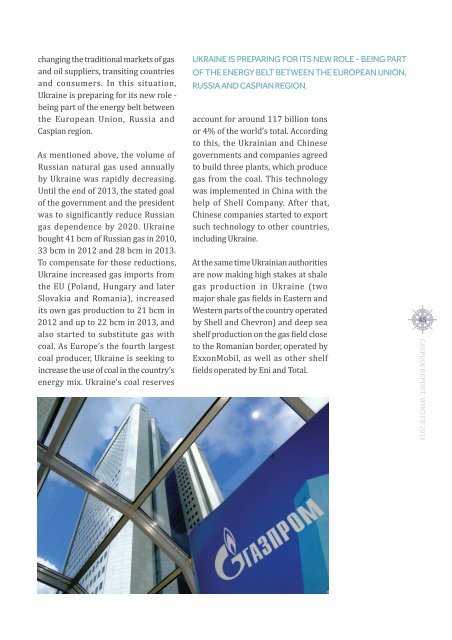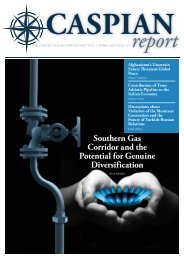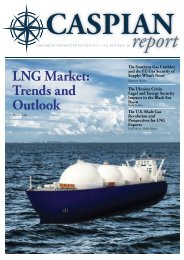Caspian Report - Issue 06 - Winter 2014
Create successful ePaper yourself
Turn your PDF publications into a flip-book with our unique Google optimized e-Paper software.
changing the traditional markets of gas<br />
and oil suppliers, transiting countries<br />
and consumers. In this situation,<br />
Ukraine is preparing for its new role -<br />
being part of the energy belt between<br />
the European Union, Russia and<br />
<strong>Caspian</strong> region.<br />
As mentioned above, the volume of<br />
Russian natural gas used annually<br />
by Ukraine was rapidly decreasing.<br />
Until the end of 2013, the stated goal<br />
of the government and the president<br />
was to significantly reduce Russian<br />
gas dependence by 2020. Ukraine<br />
bought 41 bcm of Russian gas in 2010,<br />
33 bcm in 2012 and 28 bcm in 2013.<br />
To compensate for those reductions,<br />
Ukraine increased gas imports from<br />
the EU (Poland, Hungary and later<br />
Slovakia and Romania), increased<br />
its own gas production to 21 bcm in<br />
2012 and up to 22 bcm in 2013, and<br />
also started to substitute gas with<br />
coal. As Europe’s the fourth largest<br />
coal producer, Ukraine is seeking to<br />
increase the use of coal in the country’s<br />
energy mix. Ukraine’s coal reserves<br />
UKRAINE IS PREPARING FOR ITS NEW ROLE - BEING PART<br />
OF THE ENERGY BELT BETWEEN THE EUROPEAN UNION,<br />
RUSSIA AND CASPIAN REGION.<br />
account for around 117 billion tons<br />
or 4% of the world’s total. According<br />
to this, the Ukrainian and Chinese<br />
governments and companies agreed<br />
to build three plants, which produce<br />
gas from the coal. This technology<br />
was implemented in China with the<br />
help of Shell Company. After that,<br />
Chinese companies started to export<br />
such technology to other countries,<br />
including Ukraine.<br />
At the same time Ukrainian authorities<br />
are now making high stakes at shale<br />
gas production in Ukraine (two<br />
major shale gas fields in Eastern and<br />
Western parts of the country operated<br />
by Shell and Chevron) and deep sea<br />
shelf production on the gas field close<br />
to the Romanian border, operated by<br />
ExxonMobil, as well as other shelf<br />
fields operated by Eni and Total.<br />
45<br />
CASPIAN REPORT, WINTER <strong>2014</strong>










